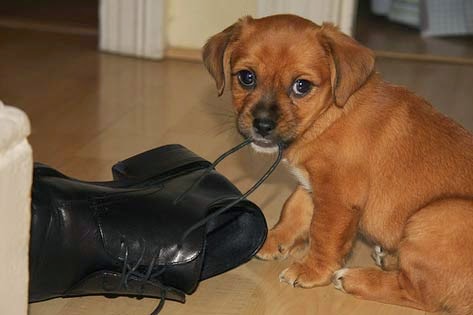The best piece of advice for raising a puppy can be summed up in one 5 letter word:
L-E-A-S-H.
A plethora of behavior problems that owners struggle with can be completely avoided if they follow one simple rule: never leave him alone to make his own decisions.
A plethora of behavior problems that owners struggle with can be completely avoided if they follow one simple rule: never leave him alone to make his own decisions.
Raising a puppy means teaching him what is
acceptable and what is not, every minute of every day. Whenever you leave a
puppy alone to make his own choices, he will always make wrong ones.
When I
am raising a puppy, he is never out of my sight for a minute unless he’s in his
crate. This is accomplished with a very sophisticated piece of training
equipment spelled: L-E-A-S-H.
When he’s not in the crate, he is on a leash attached
to me. Not only does this build confidence and trust, but it also forms a
strong bond and prevents a host of behavior problems. Inside he’s on a 6 foot leash and outside he’s
on a 20 foot leash. We do this until he
is 6 months old. Then he gets to drag the leash around behind him for a few
weeks, and if everything is going smoothly, he gets to spend some time off the
leash.
The result? When we
have a puppy in our home we have NO: housebreaking accidents, hard play biting,
destructive chewing, digging, food stealing, object stealing, not coming when
called, playing keep away, jumping all over the furniture, crate aversion,
crate soiling, crate barking, separation problems, insecurity, eating found objects,
bullying our other dogs, begging for food at the table, running out the door, or
anything else that we would rather not have him do.
Makes sense, doesn't it? Yes, but there is one problem - dog
owners absolutely HATE hearing this advice. They reject it immediately, saying things
like: “I don’t have time for that.” “We had dogs all our lives and we never
did that.” “He keeps chewing on the leash when we try that.” “I don’t want him to get too clingy.” “How is
he supposed to have any fun?” and
more.
Yes,
your puppy is going to chew on his leash unless he has something better to chew
on. So make sure he always has something better in his mouth to chew
on. And buy a few cheap throwaway leashes from the bargain bin at the pet
store.
Puppy
owners who reject my leash advice instead ask for quick tricks, “How do I stop him from....” When they ask this, they're asking how
they can punish the bad behavior. The problem with punishing young puppies is that
there are too many moving parts. Too many things can go wrong. Fearful behavior is partly genetic but partly environmental.
We cannot control the former, but we must control the latter. Rather than relying on punishing bad behavior in
a puppy, why not simply prevent it in the first place?
If you own a puppy, it's your job to teach her the rules! Responsible pet parents understand that puppies are learning new things every day. They help them learn the right things, by keeping them nearby. To accomplish this, there is no better tool than the leash.
If you own a puppy, it's your job to teach her the rules! Responsible pet parents understand that puppies are learning new things every day. They help them learn the right things, by keeping them nearby. To accomplish this, there is no better tool than the leash.
